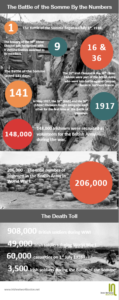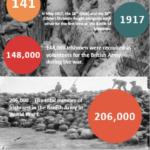 206,000 Irishmen formed part of the British Army who fought in World War I. Members of both the Ulster Volunteer Force and the National Volunteers joined due to economic circumstances or with the hope that the historic differences between both sides would be overcome and friendships would emerge. The largest numbers of Irishmen (50,107) were recruited at the beginning of the war between August 1914 and February 1915.
206,000 Irishmen formed part of the British Army who fought in World War I. Members of both the Ulster Volunteer Force and the National Volunteers joined due to economic circumstances or with the hope that the historic differences between both sides would be overcome and friendships would emerge. The largest numbers of Irishmen (50,107) were recruited at the beginning of the war between August 1914 and February 1915.
The 100th anniversary of the Battle of the Somme is being commemorated this year. It started on 1st July 1916 and continued until the following November when the weather intervened. Although the proportion of Irishmen who were engaged in this battle was small, their impact was significant, particularly on the first day.
The 36th (Ulster) Division was tasked with attacking one of the German strongholds, the Schwaben Redoubt, on the first day. Even though this Division captured the Schwaben Redoubt, they became isolated and were forced to retreat as a result of the ineffectiveness of other divisions. The 36th (Ulster) Division was relieved on 2nd July following the death of approximately 2,000 soldiers. They were moved away from the Somme, further north along the Western Front.
The total number of casualties from the Battle of the Somme exceeded 1 million, 3,500 of which were Irish.
The Battle of the Somme continued throughout the summer of 1916 with little progress. The 16th (Irish) Division achieved an important victory by capturing the villages of Guillemont and Ginchy between September 2nd and 9th. Despite this victory 1,147 men out of 2,400 were killed or wounded.
The 16th (Irish) and the 36th (Ulster) Divisions were not relieved of their duties following the Battle of the Somme. In May 1917, they fought alongside each other for the first time at the Battle of Messines. To mark the actions of the 16th and 36th Divisions, the Island of Ireland Peace Park was unveiled in Belgium in November 1998 by the president of Ireland Mary McAleese.
Approximately 49,000 Irish people died over the course of World War I. Of those, 30,986 declared Ireland as their country of birth with a further 11,000 made up of men and women from Britain who considered themselves Irish, of Irish heritage or who fought with an Irish Regiment. The highest death toll was in Antrim (5,221) followed by Dublin (4,918) and Cork (2,244).


